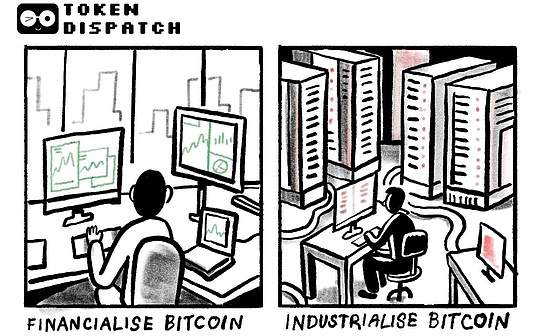
Source: Crypto Compound, compiled by Shaw bitchain vision
If you have been following the market chart recently, you will know how turbulent the cryptocurrency market is.Prices of Bitcoin (BTC) and Ethereum (ETH) fluctuated sharply – hitting new highs in one week and falling sharply the next.Headlines blame the reasons for everything from exchange-traded funds (ETFs) cash flows and macroeconomic data to giant whale sell-offs and global risk sentiment.
To me, this is nothing new.Cryptocurrencies have been in volatility.Each major cycle not only has an amazing rise, but also a sudden and heartbreaking plunge.In my opinion, it is in those sudden “flash crash” moments that the market tests people’s beliefs.Historically, when people panic and sell, they are often a time when they are patiently waiting for the rewards.
I am not here to provide financial investment advice.These are just my personal thoughts on observing the development, maturity and drastic fluctuations of this market over the years.
Why is cryptocurrency fluctuation normal
The volatility of Bitcoin and Ethereum is not a system flaw—it is inherent in its architecture.
-
Liquidity is weaker than traditional markets.The cryptocurrency market is younger and shallower than stocks or bonds.This means that a large order or a series of forced closings may affect the price more severely.
-
Cryptocurrency trading is conducted 24/7.There is no circuit breaker mechanism, nor is there a “closed market”.This leads to continuous price fluctuations and leaves more room for large fluctuations outside of traditional trading hours.
-
The macro and regulatory impact came suddenly.An ETF approval, a statement from the central bank, or a piece of words from a political leader, can cause huge uproars.
For example, before and after the halving in 2024, Bitcoin’s real volatility soared to more than 60%.Even Ethereum, which is usually considered to be a more “tech-oriented” asset, has volatility exceeding 50% for several consecutive months.These levels are far beyond traditional assets, but that’s the price of entering the cryptocurrency space.In other words, violent fluctuations are not an abnormal phenomenon, but the norm in this market.
The pain of loss – and the pattern of recovery
Cryptocurrency investors are very familiar with the decline.Bitcoin has also experienced dozens of 20% to 30% callbacks in the originally bullish years.Ethereum has experienced a more tragic collapse – its value once shrank by more than 80% in the previous cycle before rebounding to a new high.
Take Bitcoin’s history as an example:
-
2013, BTC fell by more than 70%, and then resumed long-term gains.
-
2017-18, BTC fell from its peak to the bottom, with a drop of nearly 85%.
-
2021-22, BTC fell by more than 70% again before rebounding.
Ethereum fell even more: it fell by 90% in 2018 and 80% in 2022.However, ETH survives every time and rises sharply in the next cycle.
These declines were painful at the time, but historically they were only temporary stages within the larger growth arc.The lows in each cycle are higher than the highs in the previous cycle, which suggests that market adoption and structural demand have been driving the long-term basis to continue to rise.
Why panic selling rarely works
When the market suddenly plummets, one’s instinctive reaction is fear.No one wants to see the red candlestick chart erode their investment portfolio.The sell-off seems to be in control.
But the problem is: the days when cryptocurrencies have risen the most often after the most tragic sell-offs.
Analysts have shown that if you miss the 10 best-performing days of Bitcoin in a year, your annual rate of return will drop dramatically.In some cases, it will even change from strong positive returns to flat or even negative returns.The benefits of cryptocurrencies are so concentrated.
And those days that performed best almost always occur during market volatility.If you sell in panic, you will often miss the rebound.Not only do you lock in the losses, but you also give up the opportunity to rebound.
That’s why I’m trying to avoid turning temporary losses into permanent losses.
My personal opinion on “flash crash”
Again, none of these are suggestions – just my thoughts.
1. Set the allocation interval in advance
When the market is stable, I decide how much my “core” cryptocurrency investment should be.For example, a certain proportion of BTC and ETH.I will also set a maximum allocation upper limit that will not exceed this upper limit.This predetermined range prevents me from panic selling when the price is too low or blindly buying when the price is too high.
2. Plan the area to increase positions in advance
I won’t guess the bottom, but instead set a “upload position on lows” area – like a 10%, 20%, or 30% drop from recent highs.In this way, when the market plummeted, I already knew my coping strategy.Decisions are made when the wind is calm, not in a storm.
3. Prioritize survival
The most important thing is to keep the funds adequate and stay in the market.Bitcoin’s worst decline is extremely tragic, but every time someone who controls his position and survives can benefit from it at the beginning of the next round of rise.
4. Remember that volatility is two-way
The frightening fluctuations in the downward direction are the driving force behind extraordinary returns when the upward direction.In my opinion, these are two sides of the same coin.
5. Focus on the overall situation
Every cycle, the degree of adoption is deepening.From institutional custodians to ETFs, from protocol upgrades to Layer2 expansion, the ecosystem continues to grow.The fluctuation won’t erase this.This is just a murmur on the long-term path of structural change.
Current market observation
Bitcoin has been fluctuating in the range of $108,000 to $117,000 after a sharp sell-off.Some traders view levels around $107,000 as key support levels.For me, what is more important is the market trend: will the panic and forced closing trends be digested quickly or will it continue to decline?For me, what is more important is market performance: do we see panic and forced closing quickly being digested, or are the selling orders continuing to be suppressed?
At the same time, Ethereum also has its own dynamics.Historically, its declines tend to be deeper, but Ethereum usually rebounds stronger than Bitcoin when the market turns to risk appetite again.With Ethereum ETFs already launched and more infrastructure is being built, I’m watching whether these tools will absorb the decline as Bitcoin ETFs have approved.
Why do I think fluctuations are opportunities
For me, fluctuations are not something to be avoided, but something to bear, and can even be used.
If you think Bitcoin and Ethereum are long-term storage means and basic technologies, then volatility becomes a feature rather than a flaw.It creates opportunities for accumulation when fear is high and confidence is insufficient.It eliminates those weak-willed holders and redistributes the supply to those willing to hold for a long time.
This does not mean blindly buying on dips.Instead, you must prepare in advance, understand your risk tolerance, and control your positions to avoid suffering a heavy blow in the inevitable market fluctuations.
Stay calm and look at it rationally
Every time I see a violently fluctuating red candlestick chart, I remind myself: This is cryptocurrency.This is its characteristic.The market has been rising and washing up round after round.In my experience, those who are always panic selling rarely make a profit from subsequent gains.
In fact, no one knows exactly how Bitcoin or Ethereum will be going in the next week, month or even year.But historically, those who survived volatility, maintained self-discipline, and regarded a brief plunge as part of the game often remained strong when the next round of rise came.
So my approach is simple: don’t panic, plan ahead, and remember why I got involved in cryptocurrencies in the first place.Volatility is the price we have to pay to hold cryptocurrencies.But if you learn from history, it is worth it to pay.






